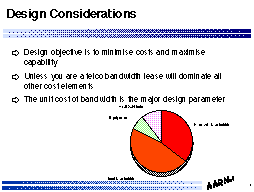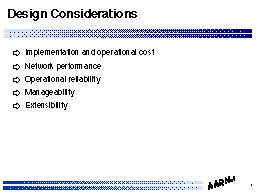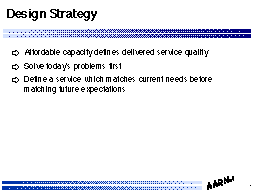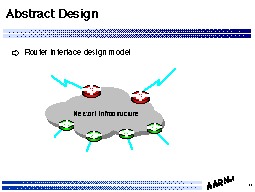 Design Considerations
Design Considerations
Geoff Huston, July 1994
Copyright (c) Geoff Huston, 1994
 Design Considerations
Design Considerations
- Design objective is to minimise costs and maximise capability
- Unless you are a telco bandwidth lease will dominate all other cost elements
The unit cost of bandwidth is the major design parameter
Once consensus on an architectural approach has been obtained the subsequent step is to translate such general principles into a specific engineering design.
In general national network services are not implemented within an environment of access to limitless resource and funding. Accordingly the major design objectives are to minimise long term operational costs and maximise service capability. Obviously these two objectives work together in a trade-off, and the engineering input is to attempt to match available resources to client expectations within the overall environment as defined by the architecture.
The most salient observation that the most significant long term operational cost for national networks is the lease of bandwidth services, for both domestic and international circuits. While equipment represents a potentially large initial capital outlay, bandwidth costs will dominate recurrent expenditure profiles. About the only exception to this observation on cost elements is in the case where the national Internet service provider is the telephone company (or a similarly positioned circuit provider), where in many cases bandwidth costs can be regarded as capital outlay costs, to be amortised over many years, and potentially over many service operations.
The resultant observation is that within the engineering of the network design, unless the activity is part of the internal operations of a national telecommunications enterprise, the unit cost of leased bandwidth becomes the major parameter in the cost and capability trade-off.
 Design Considerations
Design Considerations
- Implementation and operational cost
- Network performance
- Operational reliability
- Manageability
- Extensibility
There are a number of additional design considerations which must be factored into the overall cost - capability tradeoff within the design effort.
Within the cost factors there are considerations related to initial implementation costs and consequent recurrent operational costs. Within certain limitations there are a number of tradeoffs between these two cost areas, although it is noted that the preceding comments relating to the dominance of the bandwidth recurrent costs within the total network cost structure does imply that other cost elements are not generally such a major consideration.
The second of these design considerations is that of network performance, which in terms of the design phase is a consideration of anticipated end to end network load patterns, and the timescale of growth in load, and matching such load against planned network capacity provision. Effectively this covers the area of congestion management (or avoidance!) and instantaneous burst performance capabilities within the network. Additional performance parameters include end to end delay factoring, where topology choice and carrier mode choice (terrestrial v satellite) and possible packet reframing and data reformatting (such as compression) may impact the end to end latency timings on various paths through the network. (End to end latency is in itself a vary interesting factor, where acceptable delays tend to factor within a number of particular thresholds. Also of note is the situation of high bandwidth, high latency systems, where small configured TCP window sizes are incapable of achieving full bandwidth end to end performance on an unloaded circuit).
The next consideration is that of operational reliability, where the desire is to design a system which is operationally stable. This may encompass design considerations such as meshed internal topologies to avoid single link points of criticality and the use of communications technologies which are well proven within the environment of deployment in order to reduce the risk of extended periods of unavailability. It also encompasses issues such as routing protocol management design where the overall management approach is intended to provide the highest possible of operational integrity and overall system reliability
Manageability is effectively summarised in that the consideration that the system must be designed in such a manner that it can be managed in both an operational sense, and in terms of being capable of conforming to various managerial policies as and when necessary.
Extensibility is a reasonable reflection of the dynamic levels of growth of the Internet itself and the associated Internet technology base. To design a system within parameters of fixed capacity and a fixed service portfolio effectively implies high future cost in a re-engineering effort to include a larger scale of service operations in whatever format they may assume.
 Design Strategy
Design Strategy
- Affordable capacity defines delivered service quality
- Solve today's problems first
- Define a service which matches current needs before matching future expectations
The overall strategy within the design is to integrate the considerations described above within an overall framework of cost and capability.
The major guideline within overall design strategy is that affordable capacity will determine the quality of the delivered service. While very high speed networks can offer either high levels of burst load capacity, or service very large user populations, it is often the case that affordable networks have to compromise within these parameters, and it is reasonable to anticipate such design compromises from the outset.
Within a finite resourcing environment it is advised that the optimal design strategy is to ensure that service issues identified as current service issues are addressed within the network's intended service portfolio before attempting to integrate other services. This can be interpreted in a number of ways, including:
 Abstract Design
Abstract Design
- Router Interface design model
To provide a framework for examining the issues associated with the design of a national Internet network service, the perspective used here is that of a network interface design model.
From this perspective the network has three major components:
2. The Design of the Network
3. Engineering the Network - The Client Interface
4. Engineering the Network - External Peering
5. Engineering the Network - Infrastructure
7. The Operational Environment
GH, July 1994